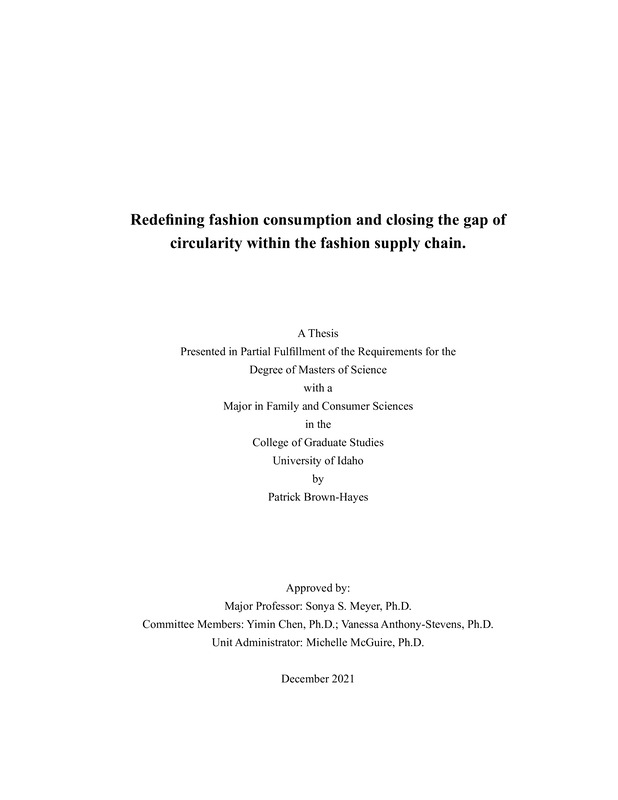Redefining fashion consumption and closing the gap of circularity within the fashion supply chain.
Brown-Hayes, Patrick David. (2021-12). Redefining fashion consumption and closing the gap of circularity within the fashion supply chain.. Theses and Dissertations Collection, University of Idaho Library Digital Collections. https://www.lib.uidaho.edu/digital/etd/items/brownhayes_idaho_0089n_12264.html
- Title:
- Redefining fashion consumption and closing the gap of circularity within the fashion supply chain.
- Author:
- Brown-Hayes, Patrick David
- Date:
- 2021-12
- Keywords:
- Circularity Consumer Behavior Entrepreneurship Fashion Market Analysis Sustainability
- Program:
- Family and Consumer Sciences
- Subject Category:
- Fashion; Entrepreneurship
- Abstract:
-
Sustainability and circularity within the retail sector have been spoken about and havegained traction within the private sector and industry-based research, they have yet to become mainstream topics in academia. Due to market conditions and consumer demand, a review of the circularity models of the fashion supply chain should be explored.
There has been a gap between academia research findings and the private sector offashion in the research findings. The analysis results indicated there is currently a line drawn in the sand between private equity and open-source data when researching the current available texts. The most searched topics and areas of interest for both interests are (in no particular order) circularity, sustainability, eco-fashion, Covid-19, consumer behavior, market analysis’, new textiles economy, micro-fiber waste, recycling, up-cycling, environmental impact, and fast fashion supply chain initiatives (Goni. et al., 2015). The results from the literature review show there are growing conditions and mountains of problems in the fashion industry with no straightforward evidence on how to fix the problem(s). Many of the previous studies provide recommendations for individual problems and hypotheses but no cut and dry solutions.
This research is grounded in pragmatism (Creswell, 2014) with a 29-questiondichotomous, likert scale, and contingency quantitative survey and creative deck project (R2A) to identify possible solutions to seven research questions within this research project. There were 221 survey participants, including male, women, and non-binary. The creative deck project is made as a pitch deck (Loomis, 2015) to illustrate a possible venture and business model to start conversations and offer potential solutions around the problems located amongst current circular business strategies within the fashion industry.
- Description:
- masters, M.S., Family and Consumer Sciences -- University of Idaho - College of Graduate Studies, 2021-12
- Major Professor:
- Meyer, Sonya
- Committee:
- Chen, Yimin; Anthony-Stevens, Vanessa
- Defense Date:
- 2021-12
- Identifier:
- BrownHayes_idaho_0089N_12264
- Type:
- Text
- Format Original:
- Format:
- application/pdf
- Rights:
- In Copyright - Educational Use Permitted. For more information, please contact University of Idaho Library Special Collections and Archives Department at libspec@uidaho.edu.
- Standardized Rights:
- http://rightsstatements.org/vocab/InC-EDU/1.0/

